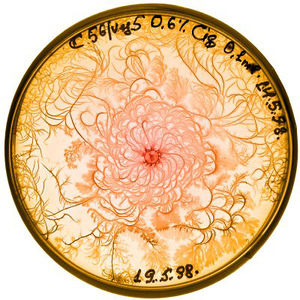Patterns of Bacterial Growth: Difference between revisions
| Line 50: | Line 50: | ||
what is cooperation? | what is cooperation? | ||
Bacteria have developed cooperative behavior to cope with difficult environmental conditions. (Ben-Jacob) | Bacteria have developed cooperative behavior to cope with difficult environmental conditions. Bacteria communicate between individual cells and with the entire colony in order to cooperatively form patterns (Ben-Jacob). Generally, a higher lever of cooperation is observed when conditions are less favorable, such as in a high-agar or low-nutrient situation. | ||
tip-splitting (T) morphotype, chiral (C) morphotype, and vortex (V) morphotype | tip-splitting (T) morphotype, chiral (C) morphotype, and vortex (V) morphotype | ||
New features emerging from the model include various modes of cell-cell signaling, such as long-range chemorepulsion, short-range chemoattraction, and, in the case of the V morphotype, rotational chemotaxis. | |||
"In general, when environmental conditions are | "In general, when environmental conditions are | ||
Revision as of 00:15, 4 December 2013
Introduction
In general, as environmental conditions become less favorable, the pattern of growth in a bacterial colony becomes more complex.
For the purposes of identifying patterns of growth, bacteria colonies can be through of as multicellular organisms. (info about communication)
Patterns of growth are a result of bacteria adapting their behavior to suit their environment.
Bacteria in the lab are grown specifically to isolate single colonies. Bacteria in the wild must cope with environmental conditions.
There are three main patterns of growth as described by Prof. Eshel Ben-Jacob of Tel-Aviv University: fine radial branches, branching patterns, and dense fingers.
Factors affecting growth
Agar density vs. nutrient density
concentration of agar controls how the bacteria move concentration of nutrients controls how fast the colony grows.
The larger the concentration of agar, the harder the resulting gel.
Bacterial growth patterns are compact at high nutrient densities, and become more fractals and peptone density decreases.
As agar density increases, the width of branches found in the fractal pattern of bacteria growth is thinner.
High nutrient level + mid-level agar = rings formed by expansion phases of bacterial growth.
If the concentration of agar is very high and the solution is very hard, then the bacteria cannot move. The colony grows in one spot, and grows radially when new bacteria are physically pushed from the center. (Lacasta) The resulting pattern of high agar concentration and high nutrient concentration is a colony with compact, concentric rings, and little to no branching. (Golding) If the nutrient level is low, then bacteria must rely on nutrients diffusing towards the colony. The resulting pattern of bacterial growth follows the diffusion-limited aggregation model.

Diffusion-limited aggregation
Diffusion-limited aggregation (DLA) is one growth model used to predict bacterial growth. It creates complex, multi-branched forms, and can be applied to any system where diffusion is the main method of particle transportation. It can be observed in bacterial growth on agar plates, dendrites, dust balls, electrodeposition, and mineral deposits.
To form a DLA pattern, begin with a seed molecule at the origin of the lattice. A "random walker" molecule diffuses from far away in a random pattern of motion. It stops once it reaches a space adjacent to the seed molecule, and another random walker is launched. In a DLA lattice, a molecule that sticks out of a main branch will not be rounded or smoothed over by new growth, but rather emphasized. Nodes are more likely to catch wandering particles because they three facets available for growth, compared to a molecule in the branch, which only has one facet.
Growth in an agar-dense, low nutrient environment is very slow. It takes approximately one month for bacteria to cover one petri dish. Growth rate increases along with nutrient density **possibly include in nutrient density section idk** (Lacasta).
Other factors
Length of cells and handedness of flagella also affect how patterns form.
Chirality is a feature of bacteria which relates to symmetry. A bacteria with high chirality is not identical to its mirror image, and a cell with low chirality is very similar to its mirror image.
Cooperation and Communication
what is cooperation?
Bacteria have developed cooperative behavior to cope with difficult environmental conditions. Bacteria communicate between individual cells and with the entire colony in order to cooperatively form patterns (Ben-Jacob). Generally, a higher lever of cooperation is observed when conditions are less favorable, such as in a high-agar or low-nutrient situation.
tip-splitting (T) morphotype, chiral (C) morphotype, and vortex (V) morphotype
New features emerging from the model include various modes of cell-cell signaling, such as long-range chemorepulsion, short-range chemoattraction, and, in the case of the V morphotype, rotational chemotaxis.
"In general, when environmental conditions are adverse (low nutrient or hard surface), a higher level of cooperation is observed." - lacasta
Conclusion
Overall text length should be at least 1,000 words (before counting references), with at least 2 images. Include at least 5 references under Reference section.
References
Edited by Eleanor Lopatto, student of Joan Slonczewski for BIOL 116 Information in Living Systems, 2013, Kenyon College.


